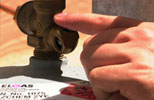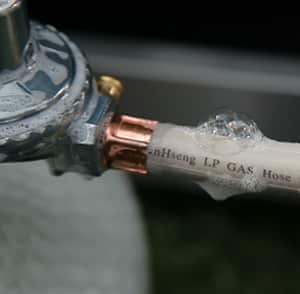How to Prevent BBQ Gas Fires
There has been a bit of news recently regarding BBQ gas fires.
So, it’s worth taking the time to review BBQ safety.
The media is fond of reporting “exploding gas cylinders”.
The reality is that LPG gas cylinders rarely explode.
In fact, it would be quite difficult to make one explode.
Preventing Gas Fires & Explosions
In summary:
• Always check for leaks, using the soapy water test, if you smell gas and every time you connect a new bottle
• Inspect the hose for cracks and other degradation on a regular basis
• Replace the hose and regulator assembly every 5 years
• Keep gas bottle upright at all times to help ensure the proper operation of the Pressure Relief Valve
• Check the gas bottle valve assembly for leaks before transporting a gas bottle in a vehicle
Pressure Relief Valve Protects You
Why is this?
 Well, gas cylinder valves are equipped with pressure relief valves.
Well, gas cylinder valves are equipped with pressure relief valves.
If the cylinder is exposed to excessive heat, the pressure relief valve allows the gas to vent and keep the pressure within safe limits.
The worst thing that can happen is the venting gas ignites and you have a plume of flame.
This will self-extinguish when the cylinder runs out of gas.
This is why you always want to use your BBQ outdoors and away from your home or other flammable materials.
Hoses & Regulators – The Usual Suspects
So what is all the media hype about?
Typically it’s about gas fires, not explosions, which result from poorly maintained BBQs.
The real culprit is typically the hose or regulator.
Hoses and regulators deteriorate with age and can start leaking.
It’s the gas coming from these leaks that ignites and causes the vast majority of BBQ fires.
Some experts recommend replacement of the hose and regulator assembly as often as every 5 years.
It should cost no more than $50 at your local BBQ store.
Check Your BBQ
How can you be sure your equipment is in good shape?
You should visually inspect the hose for cracking, splitting or other damage.
You should inspect the regulator for damage, paying special attention to the part that screws into the gas cylinder.
It should be clean, undamaged and if it has rubber O-rings, they also need to be undamaged.
BBQ Gas Leak Test
Common Problem Areas

Main Connection:
The standard BBQ regulator in Australia is a POL regulator.
The male connector of the regulator, which screws into the gas valve on your gas bottle, may have a rubber O-ring seal or it may rely on a metal to metal contact seal.
You should always inspect the regulator for damage, paying special attention to the connector, which screws into the gas bottle.
If it has a rubber O-ring, it also needs to be undamaged.
The connector and the female valve opening should both be clean and undamaged.
Gas Hose
 The gas hose is attached to the regulator on one end and the BBQ on the other end.
The gas hose is attached to the regulator on one end and the BBQ on the other end.Valve Stem
In Australia, BBQ gas bottles must be tested every ten years.
The gas valve is changed upon inspection and the valves are expected to last for the full ten years.
However, occasionally the valve will fail prematurely and start leaking from around the valve stem. This is rare but it can happen.
Bleed Screw
The bleed screw is a small slotted screw on the side of the valve that lets gas vapour bleed off during the decanting refill process.
The refill technician opens it during the filling process and closes it, when done.
The screw can develop a slow leak if it becomes loose.
How To Do The Test
When to Test
Soapy Water Solution
You will need a soapy water solution to check for any leaks.
Mixing liquid hand soap with water should work fine.
Place the solution in a liquid spray bottle.
It’s a good idea to leave the spray bottle with the BBQ, so it’s always a handy reminder to perform the leak test.
No Ammonia
Doing the Soapy Water Test
Put some soapy water in a spray bottle or a dish.
Turn on the gas bottle without turning on the BBQ.
This pressurises the system.
Next, spray the entire valve, regulator and hose assembly with the soapy water.
Alternatively, you can apply the soapy water with a paint brush, basting brush or it can even be sponged on.
Bubbles will form if there is a gas leak and you may also smell the gas.
Extra Safety Tip
 The best practice gas safety advice is that gas bottles should only be in a vehicle for the minimum required transport time.
The best practice gas safety advice is that gas bottles should only be in a vehicle for the minimum required transport time.
When you do transport a gas bottle, you should consider one added precaution.
After making sure that the valve is firmly closed, you should spray the entire valve assembly to check for any possible leaks, prior to transport.
DO NOT leave BBQ bottles in enclose vehicle unnecessarily.
In addition, you should always turn the gas cylinder off, when not in use.
In fact, you should turn the BBQ off at the cylinder first, when you are done cooking.
- Elgas to the Rescue with Helicopter LPG Delivery - November 14, 2024
- Gas Patio Heater Guide: Outdoor Gas Heaters – Outdoor Mushroom Heater - September 22, 2024
- LPG Meaning – LPG Means: What Does LPG Stand For - August 31, 2024
Steve Reynolds
Technical Consultant
Steve Reynolds is a leading expert in the LPG industry with over 22 years of experience. As part of the national management team at ELGAS, Steve ensures the safe and efficient storage, handling, and transportation of LPG. He serves as the lead investigator for incidents and collaborates with authorities on industry developments.
Steve is a technical advisor to Standards Australia and Gas Energy Australia (GEA), and an active member of the World LPG Association (WLPGA), contributing to global standards and technical reviews. He holds a BSc. (Hons) in Industrial Chemistry from UNSW and has held senior safety and technical roles at ELGAS, making him a trusted authority in LPG safety and standards.





